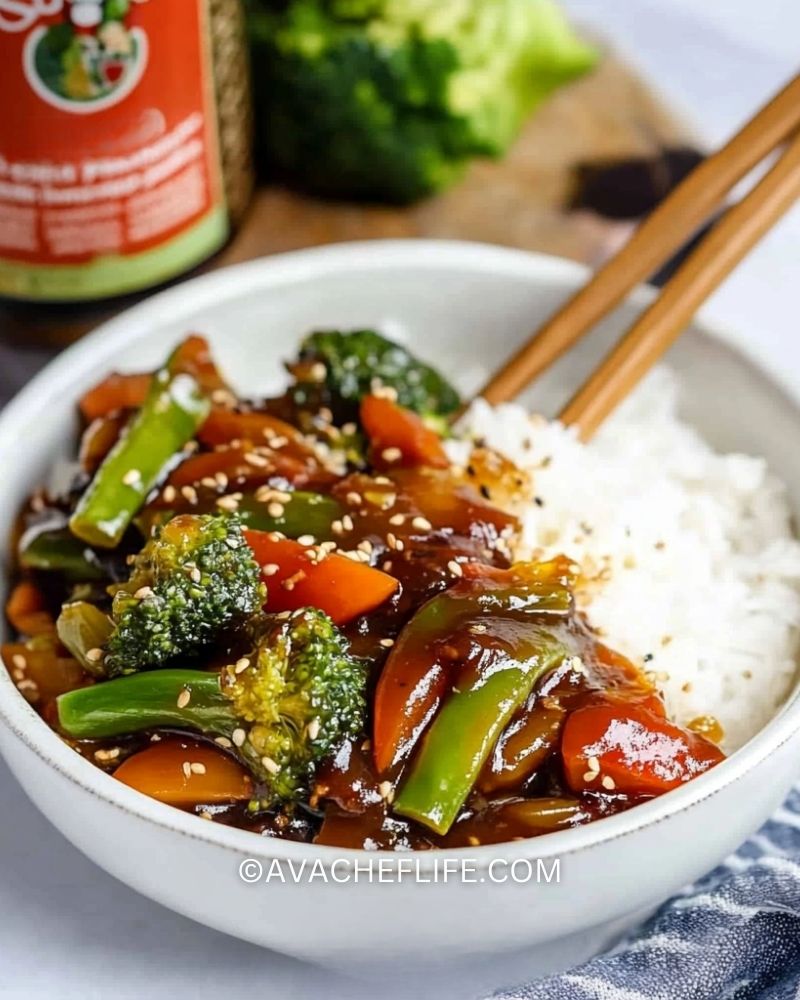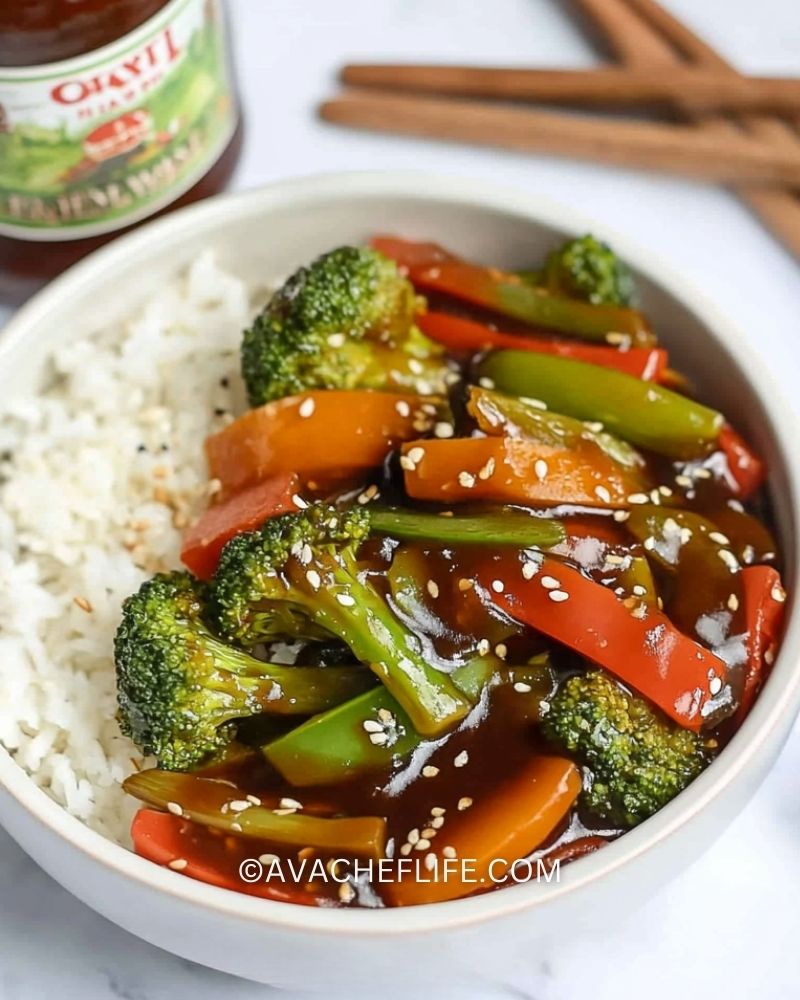Stir-fry sauce is the secret ingredient that transforms simple vegetables and proteins into a flavorful, restaurant-quality dish. I love how this sauce balances sweet, savory, and umami flavors, making it the perfect addition to any stir-fry. Whether I’m cooking up a quick weeknight meal or meal prepping for the week, having a homemade stir-fry sauce on hand makes everything easier and tastier.

What’s great about this sauce is its versatility. It works with chicken, beef, shrimp, tofu, or just a medley of fresh vegetables. I can control the ingredients, adjust the sweetness or spice level, and avoid unnecessary preservatives found in store-bought versions. With just a few pantry staples, this stir-fry sauce comes together in minutes, making it a must-have in my kitchen.
Why You’ll Love This Stir-Fry Sauce
- Quick & Easy – Ready in just a few minutes, perfect for busy nights.
- Versatile – Works with any protein or vegetable combination.
- Customizable – Adjust sweetness, saltiness, or spice to your taste.
- Better Than Store-Bought – No preservatives or artificial flavors.
- Meal Prep Friendly – Make a batch and store it for future use.
What Ingredients Make the Best Stir-Fry Sauce?
The beauty of a good stir-fry sauce is in its balance of flavors. A combination of salty soy sauce, a hint of sweetness from honey or brown sugar, and a touch of acidity from rice vinegar or lime juice creates the perfect base. Adding fresh garlic, ginger, and a little cornstarch for thickness ensures a rich and glossy sauce that clings to every ingredient in the stir-fry.
Some people like their sauce with a bit of heat—red pepper flakes or sriracha can do the trick. Others prefer a deeper umami flavor, which can be enhanced with oyster sauce or a splash of sesame oil. No matter how you tweak it, having a solid base recipe makes customizing easy.
Options for Substitutions
- Soy Sauce Alternatives – Use tamari for a gluten-free option or coconut aminos for a lower-sodium alternative.
- Sweetener Swaps – Brown sugar, honey, maple syrup, or even a bit of pineapple juice can replace traditional sugar.
- Thickening Agents – Cornstarch is common, but arrowroot powder or tapioca starch work as well.
- Gluten-Free Option – Replace regular soy sauce with gluten-free soy sauce or tamari and ensure any additional sauces used are gluten-free.
- More Umami Flavor – Try adding a teaspoon of miso paste, hoisin sauce, or a splash of fish sauce for depth.
- Extra Spice – Sriracha, crushed red pepper flakes, or a dash of chili oil can bring the heat.
Ingredients for This Stir-Fry Sauce
- Soy Sauce – The salty, umami-rich base that brings depth to the sauce. Use light soy sauce for a balanced flavor or dark soy sauce for a richer color.
- Brown Sugar or Honey – Adds a touch of sweetness to balance out the saltiness and acidity.
- Garlic & Ginger – Freshly minced garlic and ginger bring warmth and bold flavor.
- Rice Vinegar – Provides a slight tang to balance the sweetness and enhance the overall taste.
- Sesame Oil – A small amount adds a nutty aroma and enhances the Asian-inspired flavors.
- Cornstarch – Helps thicken the sauce so it coats the stir-fry ingredients perfectly.
- Water or Chicken Broth – Thins out the sauce while adding extra depth of flavor.
- Oyster Sauce (Optional) – Gives a rich, slightly sweet umami boost.
- Sriracha or Red Pepper Flakes (Optional) – Adds a bit of heat for those who like spice.

Step 1: Mix the Ingredients
In a small bowl, whisk together the soy sauce, brown sugar (or honey), rice vinegar, sesame oil, minced garlic, and grated ginger. If you’re adding optional ingredients like oyster sauce or sriracha, mix them in as well. This ensures that all the flavors blend evenly.
Step 2: Add the Thickener
In a separate small bowl, dissolve the cornstarch in a few tablespoons of water or broth. This step prevents clumps and helps create a smooth, glossy sauce. Once dissolved, pour it into the soy sauce mixture and stir well.
Step 3: Cook the Sauce
Heat a small saucepan over medium heat. Pour in the sauce mixture and bring it to a gentle simmer while stirring continuously. Within a few minutes, the sauce will start to thicken. If it gets too thick, add a splash of water to loosen it up.
Step 4: Use or Store
Once the sauce reaches your desired consistency, remove it from the heat. Use it immediately by pouring it over stir-fried vegetables, meat, or tofu, or let it cool and store it in an airtight container in the refrigerator for later use.
How Long to Cook the Stir-Fry Sauce
This sauce comes together in just 3-5 minutes on the stove. Once the ingredients are combined, it thickens quickly when heated. Keep stirring to prevent lumps, and as soon as it reaches a glossy, smooth consistency, it’s ready to use. If making it ahead, store it in the fridge and reheat gently before using.
Tips for Perfect Stir-Fry Sauce
- Dissolve Cornstarch First – Always mix cornstarch with water before adding it to the sauce to prevent clumps.
- Use Fresh Garlic & Ginger – Fresh ingredients give the sauce the best flavor compared to powdered alternatives.
- Simmer, Don’t Boil – Cooking the sauce over medium heat allows it to thicken gradually without burning.
- Adjust Thickness as Needed – If the sauce is too thick, add a little water or broth. If it’s too thin, simmer a bit longer.
- Taste & Adjust – Before removing from the heat, do a quick taste test and adjust sweetness, saltiness, or spice as needed.
- Make a Big Batch – This sauce stores well in the fridge, so doubling the recipe is great for meal prep.
Watch Out for These Mistakes While Cooking
- Skipping the Cornstarch Slurry – Adding dry cornstarch directly to the sauce can cause lumps. Always dissolve it in water first.
- Overcooking the Sauce – Cooking it for too long can make it too thick or even cause it to burn. Remove from heat as soon as it thickens.
- Using Low-Quality Soy Sauce – A good soy sauce makes all the difference. Low-sodium or premium varieties enhance the flavor.
- Adding Too Much Sugar – While sweetness balances the flavors, too much can make the sauce overpowering. Adjust gradually.
- Forgetting the Vinegar or Acidic Element – A splash of rice vinegar or lime juice helps cut through the richness and creates a balanced sauce.
- Not Tasting Before Using – Always sample the sauce and tweak the seasonings before adding it to your stir-fry.
- Pouring Cold Sauce Over Hot Ingredients – If you’ve stored the sauce in the fridge, warm it up before adding it to a hot pan.
- Using Too Much Sauce – Stir-fry should be coated, not drenched. A little sauce goes a long way!
What to Serve With Stir-Fry Sauce?
1. Classic Stir-Fried Vegetables
Toss broccoli, bell peppers, carrots, and snap peas in this sauce for a quick, healthy side dish.
2. Chicken Stir-Fry
Pair this sauce with diced chicken breast or thighs for a flavorful protein-packed meal.
3. Beef & Broccoli
A takeout favorite—thinly sliced beef and steamed broccoli coated in this sauce make for a delicious dinner.
4. Shrimp Stir-Fry
Shrimp cooks quickly and absorbs the sauce beautifully for a fast and easy meal.
5. Noodles or Lo Mein
Drizzle this sauce over cooked noodles for a simple but flavorful dish.
6. Fried Rice
Use it to season homemade fried rice with eggs, veggies, and leftover proteins.
7. Tofu Stir-Fry
Crispy tofu cubes soak up the sauce, making it a great plant-based option.
8. Asian-Inspired Wraps
Use this sauce as a marinade or drizzle inside lettuce wraps with chicken, beef, or tofu.
Storage Instructions
Homemade stir-fry sauce is perfect for meal prep and can be stored for later use. Here’s how to keep it fresh:
- Refrigerator – Store the sauce in an airtight jar or container for up to one week. Give it a quick stir before using.
- Freezer – Pour the sauce into an ice cube tray and freeze. Once frozen, transfer the cubes to a sealed bag and store for up to 3 months. This makes it easy to grab a portion when needed.
- Reheating – If the sauce thickens too much in the fridge, warm it up on the stove over low heat, adding a splash of water or broth to loosen it.
Estimated Nutrition (Per Serving – About 2 Tablespoons)
- Calories: ~50
- Carbohydrates: 9g
- Protein: 2g
- Fat: 1g
- Sodium: ~500mg (varies depending on soy sauce)
- Sugar: 4g
Note: Nutrition values may vary based on ingredient brands and portion sizes.
Frequently Asked Questions
1. Can I Make This Stir-Fry Sauce Ahead of Time?
Yes! This sauce stores well in the fridge for up to a week or in the freezer for up to three months. Just give it a stir or reheat it before using.
2. How Can I Make It Gluten-Free?
Use tamari or coconut aminos instead of regular soy sauce. Also, double-check that any additional ingredients, like oyster sauce, are gluten-free.
3. How Can I Make It Spicier?
Add sriracha, red pepper flakes, chili paste, or a drizzle of chili oil for extra heat. Adjust to taste.
4. Can I Use a Different Sweetener?
Absolutely! Brown sugar, honey, maple syrup, or even a bit of pineapple juice work well to balance the flavors.
5. What If My Sauce Is Too Thick?
Simply stir in a little water or broth while reheating to loosen it up to the desired consistency.
6. Can I Skip the Oyster Sauce?
Yes! While it adds umami depth, you can leave it out or replace it with hoisin sauce or a splash of fish sauce.
7. Can I Use This Sauce as a Marinade?
Definitely! It works great for marinating chicken, beef, shrimp, tofu, or even vegetables before cooking.
8. Can I Use This Sauce for Fried Rice?
Yes! Drizzle it over cooked rice with stir-fried veggies and protein for a quick and delicious fried rice dish.
Conclusion
This homemade stir-fry sauce is a game-changer for quick and flavorful meals. Whether you’re making a veggie stir-fry, coating your favorite protein, or adding it to noodles, this sauce is incredibly versatile. Save this recipe on Pinterest, share it with friends, and keep it handy for all your stir-fry cravings!

Stir Fry Sauce
- Prep Time: 5 minutes
- Cook Time: 5 minutes
- Total Time: 10 minutes
- Yield: 3/4 cup
Description
This homemade stir-fry sauce is a perfect balance of savory, sweet, and umami flavors, making it ideal for quick and easy meals. Use it on vegetables, chicken, beef, shrimp, or tofu. It’s versatile, meal-prep friendly, and better than store-bought versions. Perfect for stir-fries, noodles, and rice dishes!
Ingredients
- 1/2 cup soy sauce
- 1/4 cup water or chicken broth
- 2 tablespoons brown sugar or honey
- 1 tablespoon rice vinegar
- 1 teaspoon sesame oil
- 2 teaspoons cornstarch
- 2 cloves garlic, minced
- 1 teaspoon fresh ginger, grated
- 1 tablespoon oyster sauce (optional)
- 1 teaspoon sriracha or red pepper flakes (optional)
Instructions
- In a small bowl, whisk together soy sauce, water (or broth), brown sugar, rice vinegar, sesame oil, minced garlic, and grated ginger.
- In a separate small bowl, dissolve the cornstarch in a few tablespoons of water, then stir it into the soy sauce mixture.
- Heat a small saucepan over medium heat and pour in the sauce mixture.
- Stir continuously and bring to a gentle simmer. Cook for 3-5 minutes until the sauce thickens.
- Remove from heat and use immediately, or let it cool and store in an airtight container in the fridge.

